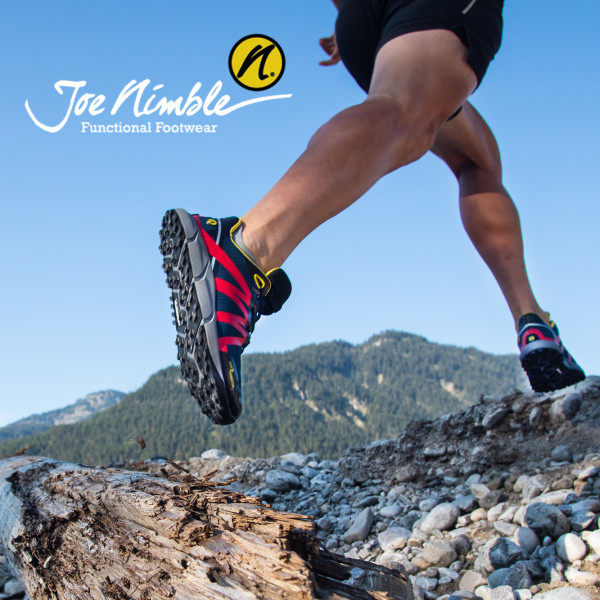
MORE stability + MORE protection + MORE toefreedom® = LESS pain!*
We engineered freedom so you can enjoy it!
The Functional Footwear design concept is based on the principle of toefreedom®, which provides the runner with an increase in stability due to extra room for the big toe to anchor, stabilize and control the foot. The rest of the body can relax, move efficiently and avoid overuse and unnatural stresses on joints and muscles.
In conventional footwear, the toes (especially the big toe) are squished and cannot perform their natural function to anchor and stabilize the foot. As a result you stand, walk and run on an unstable base which leads not only to discomfort but is also the most common denominator for pain and injury.
*References below

__________________________________________________________________________________________
The nimbleToes Trail Addict

__________________________________________________________________________________________
Why toefreedom®?
We at Joe Nimble believe, that a tree is only as strong as its roots; just as the roots of a tree adapt to the shape of a container, the shape of the foot adapts to the shoes you are wearing. Conventional shoes with a shoe-shaped toebox create unnatural, shoe-shaped feet. From the assessment of thousands of feet worldwide, we have learned that just as weak and twisted tree roots affect the stability of the trunk and branches above, so do weak and twisted toes affect the stability of the runner above.
*References below


__________________________________________________________________________________________

__________________________________________________________________________________________
We made sure you will love this shoe!

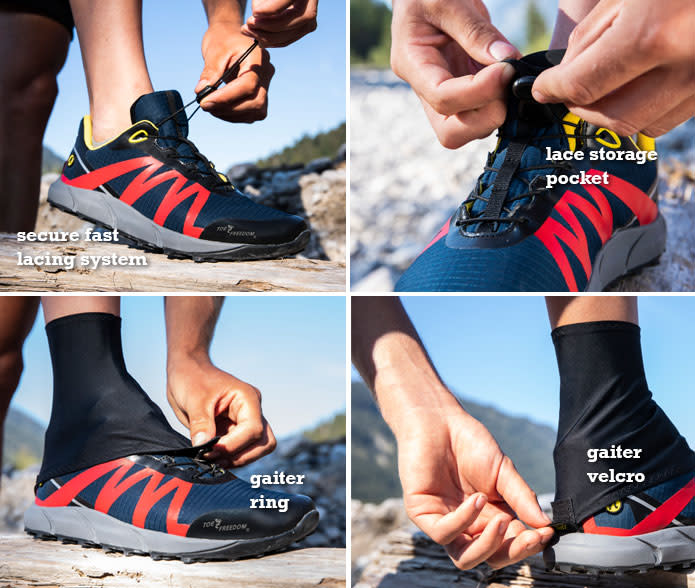
__________________________________________________________________________________________
The skill of trailrunning
Common injuries in trail running like knee-, metatarsal- and lower back-pain are due to a lack of skill in switching between gears. The combined benefits of the toefreedom® concept and the flexitec insole have never been offered before in a trail running shoe and we believe this unique combination can be an essential part of the solution to pain-free trail running.
*References below

BIOMECHANIST, RUNNING COACH AND CREATOR OF THE FUNCTIONAL FOOTMAP.
Lee is one of the most recognised coaches for running technique on an international level.
His knowledge and experience in running biomechanics and foot function has benefited injured runners, both recreational and elite around the globe and led him to develop the Functional FootMap assessment system.
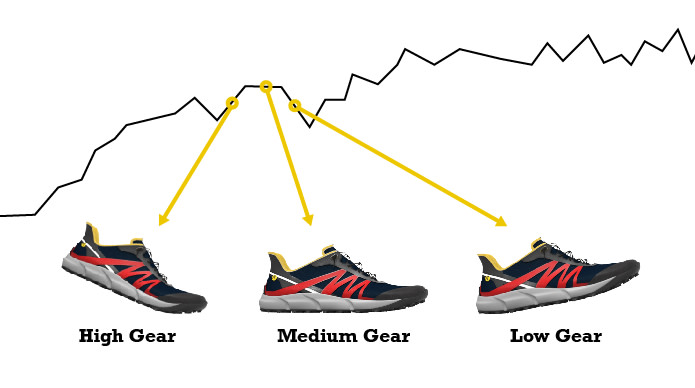

__________________________________________________________________________________________
Protection
Protective FLEXITEC® insole
The 4mm thin spring-steel insole is modelled on the anatomy of the foot. Its unique construction promotes an even weight and pressure distribution throughout the foot and ads an extra layer of protection from sharp, irregular objects on the trail. Experience a new level of confidence and performance during your run, after inserting this simple but brilliant piece of innovation.
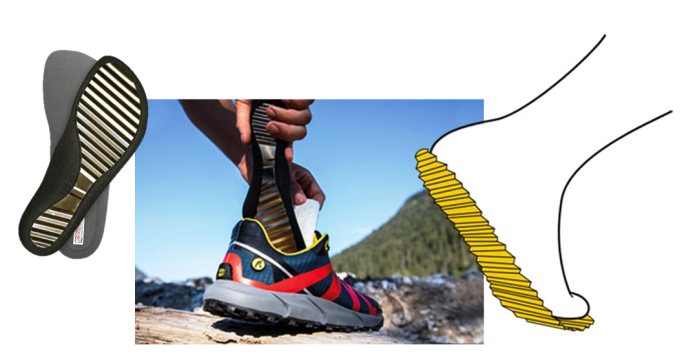

SHOE PIONEER AND INVENTOR OF THE FUNCTIONAL FOOTWEAR DESIGN CONCEPT
Sebastian´s family has been making shoes with toefreedom® for over three decades. His experience of helping people all around the world to improve their foot function through the benefits of toefreedom® and his passion for running has led him to create the Functional Footwear Design Concept.
__________________________________________________________________________________________
Stability


__________________________________________________________________________________________
Traction
Soles by Michelin Technology
Michelin has been forging a better way forward for over 100 years. They have spanned millions of miles on the mission to develop groundbreaking multi-surface contact for vehicles operating in the most challenging environments all over the world. We decided to partner with Soles by Michelin because of their unrivalled expertise in rubber and tread design to equip our nimbleToes Trail Addict with the perfect outsole for Functional Footwear to meet the unique demands of trailrunning.

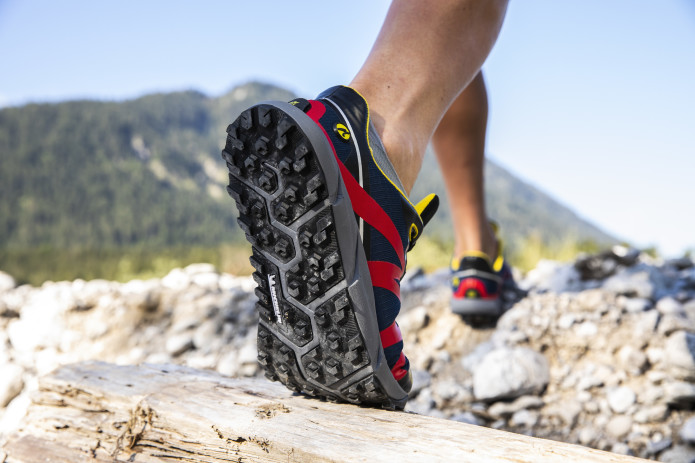
__________________________________________________________________________________________
Inspiration
Badwater Ultra – the world´s toughest footrace
When crewing at the worlds toughest footrace, the Badwater Ultramarathon, a few years ago, Sebastian observed that a lot of the elite athletes cut open the front of their running shoe to have more freedom for their toes and reduce the risk of injury. His unique know-how in making casual shoes with toefreedom® inspired him to introduce this design philosophy to the running shoe industry.

__________________________________________________________________________________________
“Function”
noun
an activity that is natural to or the purpose of a person or thing. (Oxford English Dictionary)
The purpose of the foot is to provide a stable base of support to control the direction of the body weight during the stance phase of locomotion [1-3]. Newtonian physics dictates that a wider base of support is more stable than a narrow base. Width and stability of the forefoot is crucial in this regard as the highest forces during mid stance occur at the forefoot [4, 5]. A greater spread of the toes, the great toe in particular, reduces forefoot peak pressures, distributes force more evenly, and stabilises the foot and ankle [6-8]. Toes squashed together by years of wearing narrow shoes that do not respect the natural fan shape of the human foot [9] are common [10] and are linked to instability and movement-related pain [11, 12]. Natural function can be restored by regular loading of the feet in footwear that respect natural design of the foot [13] and permit freedom for the toes to spread and stabilise the foot.
Pain-free movement begins with a stable base of support. A stable foot requires Toe freedom, only functional footwear provides toe freedom. Joe Nimble ‘functional footwear’ is based on this science.
*References below


DR WILKINSON
Dr Wilkinson´s research area is the biology of human health and performance. His work has included the biomechanics and performance determinants of distance running and the link between plantar sensation and regulation of bipedal gait. He has a particular interest in the influence of footwear on foot structure, function and joint loading during running.

__________________________________________________________________________________________
Ambassadors

__________________________________________________________________________________________
The History of toefreedom®
__________________________________________________________________________________________
Testimonials

__________________________________________________________________________________________

If you’re new to Joe Nimble Functional Footwear you might be wondering what the right shoe size is you should buy. Well, the good news is: You just need to order your regular shoe size.
MEASURE YOUR FEET
If you are not sure about your right shoe size, here are some simple instructions for measuring your feet. You only need:
- a sheet of paper
- a pencil
- a ruler or measuring tape
This is how it works: Stand on the paper with both feet while you are wearing socks. Simply trace around the outline of your feet with a pencil one after the other.
Important: Always hold the pencil upright on the paper, not leaning tot he inside or outside in order to get an accurate result.
Now simply measure the length of your drawing. Measure from the tip oft he longest toe tot he bottom (at the center) of your heel. If your feet are different sizes, then the bigger foot determines the correct shoe size.
__________________________________________________________________________________________

__________________________________________________________________________________________
Perks
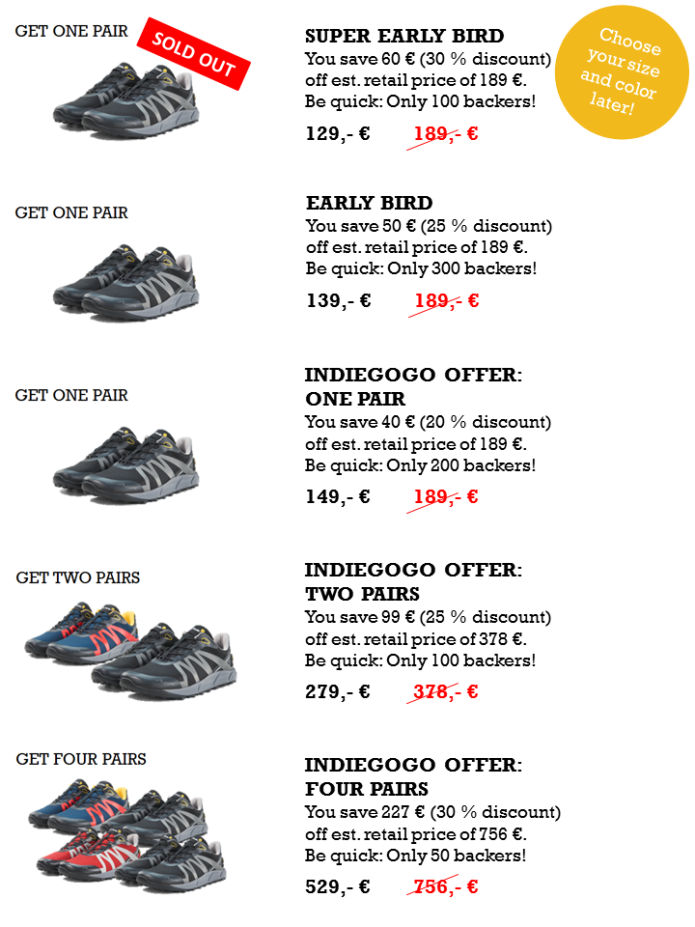
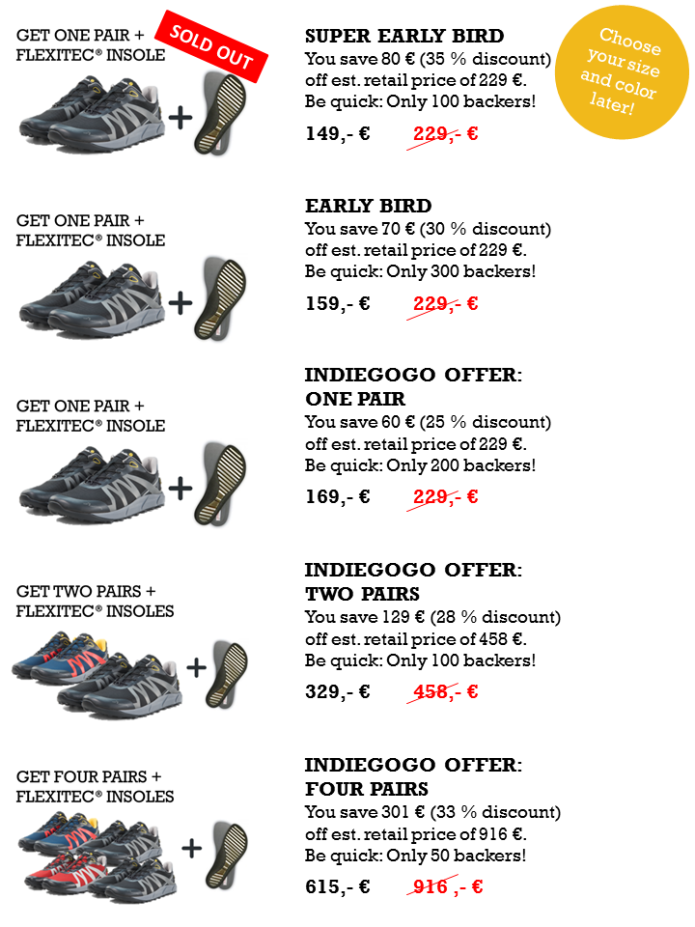
__________________________________________________________________________________________
Social Media
You can find more information about Joe Nimble here:
Joe Nimble on the web: https://joe-nimble.com/int
Joe Nimble on Facebook: www.facebook.com/joenimbleDE
Joe Nimble on Instagram: www.instagram.com/joenimble
Joe Nimble on YouTube: https://bit.ly/2Q1EJVV
Joe Nimble Blog: https://www.joe-nimble.com/int/explore/the-scie…
myFoot education: http://myFoot.com
__________________________________________________________________________________________
__________________________________________________________________________________________

*** Free shipping wordwide (except Russian Federation)***
** Campaign ends 09. September 2020 midnight (CET) **
* We will get in touch with you after the campaign ends*
__________________________________________________________________________________________
References 1: Running related pain and injury
* Most running related injuries (RRIs) can be classified as ‘overuse’ injuries which occur from the accumulative loading of the musculoskeletal system beyond it’s capacity to recover and adapt (1). Approximately 60% of RRIs are caused by training errors which result from doing TOO much, TOO soon with TOO little rest in between training sessions (2,3). The remaining 40% of RRIs are caused by anatomical factors, running shoes and training surfaces which independentlyand in combination affect the biomechanical behavior of the foot and the loading of the ankle, knee, hip and lumbopelvis (2,3,4). The interaction of the foot-shoe-surface and it’s effect on running biomechanics can therefore be considered to bethe most important influence on RRIs after ‘training errors’ and the selection of the most appropriate shoe based on the runner’s level of foot function, age, weight and chosen running surface should be considered fundamental to the prevention of injury and pain-free running (2,3,5,6).
For more information and to see a full list of common running related pain and injuries please see the sources attached:
1. Hreljac A. (2005) Etiology,Prevention and Early Intervention of Overuse Injuries in Runners: A Biomechanical Perspective. Phys Med Rehabil Clin N Am (https://pubmed.ncbi.nlm.nih.gov/16005398/).
2. James, S. L., Bates, B. T., & Osternig, L. R. (1978). Injuries to runners. The American journal of sports medicine, 6(2), 40-50. (https://journals.sagepub.com/doi/pdf/10.1177/03…)
3. Clement C., D. B., Taunton, J. E., Smart, G. W., & McNicol, K. L. (1981). A survey of overuse running injuries. The Physician and Sportsmedicine, 9(5), 47-58. (https://www.tandfonline.com/doi/pdf/10.1080/009…).
4. Dodelin D, Tourny C, L’Hermette M. (2020). The biomechanical effects of foot-function on gait. An experimental study. Scandinavian Journal of Medicine and Science in Sports (https://onlinelibrary.wiley.com/doi/abs/10.1111…).
5. Johnston C.A.M, Taunton J.E, Lloyd-Smith D.R, McKenzie D.C. (2003) Preventing Running Injuries: Practical approach for family doctors. Canadian Family Physician (https://www.ncbi.nlm.nih.gov/pmc/articles/PMC22…).
6. Bates, B. T., Dufek J. S., & Stergiou, N. (2020). Advanced biomechanics. In: Stergiou, N. (2020) Biomechanics and Gait Analysis, 65-80 (DOI: https://doi.org/10.1016/B978-0-12-813372-9.00003-8)
References 2: The Science
1. Mann R and Inman VT. Phasic Activity of Intrinsic Muscles of the Foot. The Journal of Bone and Joint Surgery 1964 46 (3): 469-481. (https://pubmed.ncbi.nlm.nih.gov/14131426/)
2. Reeser LA, Susman RL, and Stern JT. Electromyographic Studies of the Human Foot: Experimental Approaches to Hominid Evolution. Foot and Ankle 1983 3(6): 391-407. (https://pubmed.ncbi.nlm.nih.gov/6409717/)
3. Rolian C, et al. Walking, running and the evolution of short toes in humans.
Journal of Experimental Biology 2009 212: 713-721. (https://pubmed.ncbi.nlm.nih.gov/19218523/)
4. Wilkinson M and Saxby L. Form determines function: Forgotten application to the human foot? . Foot and Ankle Online Journal 2016 9(2): 5-8. (https://faoj.org/2016/06/30/form-determines-function-forgotten-application-to-the-human-foot/)
5. Wilkinson M, Stoneham R, and Saxby L. Feet and footwear: Applying biological design and mismatch theory to running injuries. International Journal of Sports and Exercise Medicine.
2018 4(2). (https://clinmedjournals.org/articles/ijsem/international-journal-of-sports-and-exercise-medicine-ijsem-4-090.pdf)
6. D’Aout K, et al. The effects of habitual footwear use: foot shape and function in ntaive barefoot walkers.Footwear Science 2009 1(2): 81-94. (https://www.tandfonline.com/doi/abs/10.1080/19424280903386411?journalCode=tfws20)
7. Mei Q, et al. A comparative biomechanical analysis of habitually unshod and shod runners based on foot morphological difference. Human Movement Science 2015 42: 38-53. (https://pubmed.ncbi.nlm.nih.gov/25964998/)
8. Shu Y, et al. Dynamic loading and kinematics analysis of vertical jump based on different forefoot morphology. SpringerPlus 2016 5: 1999. (https://www.ncbi.nlm.nih.gov/pmc/articles/PMC5120166/)
9. Munteanu SE, et al. Hallux valgus, by nature or nurture? A twin study. Arthritis Care and Research 2017. (https://pubmed.ncbi.nlm.nih.gov/27863158/)
10. Nix S, Smith M, and Vicenzino B. Prevalence of hallux valgus in the general population: a systematic review and meta analysis. Journal of Foot and Ankle Research 2010 3: 21. (https://pubmed.ncbi.nlm.nih.gov/20868524/)
11. Vorobiev G. Evolution of injuries in athletics. New Studies in Athletics 1999 4: 23-26.
12. Travell J and Simons D, Myofascial Pain and Dysfunction: The Trigger Point Manual. 1993: Lippincott Williams & Wilkins
13. Knowles FW. Effects of shoes on foot form: An anatomical experiment. The Medical Journal of Australia 1953 1(17): 579-581. (https://pubmed.ncbi.nlm.nih.gov/13062868/)





